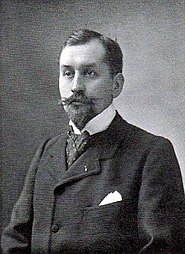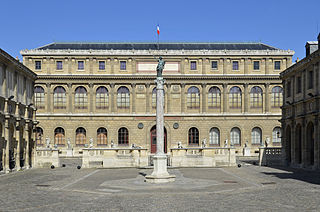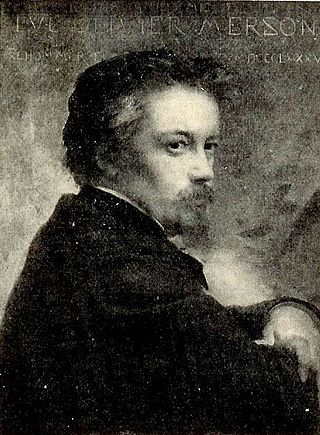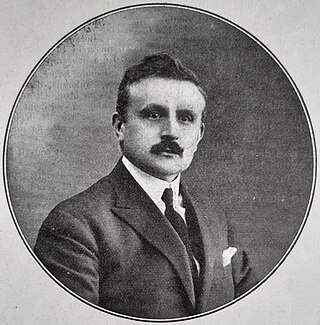This article needs additional citations for verification .(March 2022) |

Gustave Umbdenstock (24 December 1866, Colmar - 16 November 1940, Paris) was a French architect most familiar for his railway stations.
This article needs additional citations for verification .(March 2022) |

Gustave Umbdenstock (24 December 1866, Colmar - 16 November 1940, Paris) was a French architect most familiar for his railway stations.
His father, also named Gustave, was a cloth merchant. From 1885, he was a student of Julien Guadet at the École des Beaux-Arts; receiving his diploma in architecture in 1893, and becoming an assistant professor there in 1894. He won the Prix de Rome in 1896, with his design for a naval school. The following year, he married Marie Charlotte Jeanne Normand, the daughter of one of his father's associates.
In 1898, he was commissioned by the Ministries of War and the Navy to construct the "Palais des armées de terre et de mer" (Palace of the Army and Navy) for the Exposition Universelle of 1900. As a reward for his work, he was named a Knight in the Legion of Honor. [1] Drawing on his work there, he was named Chief Architect for the construction of the "Palais de France" at the Louisiana Purchase Exposition (1904) in St. Louis.
After 1901, much of his career was devoted to teaching at the École polytechnique, where he became a full Professor in 1919, and taught until his retirement in 1937. In 1909, he became the workshop manager at the École des Beaux-Arts; a position he held until his death. Two of his best known students were Paul Metz and Étienne de Kalbermatten [2] In 1903, he wrote a textbook for their classes (Cours d'architecture, Gauthier-Villars et Cie).
For many years, he worked as an architect for the Chemins de Fer du Nord, built several stations for them, and participated in reconstructing their network of stations after World War I. During that time, he also served as a member of the "Council of Buildings and Lycées" at the Ministry of Public Instruction; in charge of the construction of high schools and other public buildings. In 1935, he succeeded Henri-Paul Nénot (deceased) in Seat #5 at the Académie des Beaux-Arts, architecture section.
His last major project involved a silo at the Seegmuller Pier , in Strasbourg (1932). As a painter, he was an accomplished watercolorist; making landscapes during his travels. A street in Colmar is named after him.

The Beaux-Arts de Paris, formally the École nationale supérieure des beaux-arts, is a French grande école whose primary mission is to provide high-level fine arts education and training. The art school, which is part of the Paris Sciences et Lettres University, is located on two sites: Saint-Germain-des-Prés in Paris, and Saint-Ouen.

Luc-Olivier Merson was a French academic painter and illustrator. He was also known for his postage stamp and currency designs.

Victor-Alexandre-Frédéric Laloux was a French Beaux-Arts architect and teacher.

Paul Tournon was a French architect. He was born in Marseille and died in Paris.

Jean-Jacques-Marie Huvé was a French architect who practiced in Paris, working in a neoclassical manner that he refined working in the atelier of Percier and Fontaine, Napoleon's chief architects.
Henri-Georges Adam was a French engraver and non-figurative sculptor of the École de Paris, who was also involved in the creation of numerous monumental tapestries. His work in these three areas is regarded as among the most extensive of the twentieth century.

Emmanuel Pontremoli was a French architect and archaeologist.

Roger-Henri Expert was a French architect.

Léon Azéma was a French architect. He is responsible for many public works in France, especially in and around Paris. His most famous work is 1937 Palais de Chaillot, facing the Eiffel Tower in Paris.
Marcel Gaumont was a French sculptor born on 27 January 1880 in Tours. He died in Paris on 20 November 1962.

Louis Leygue was a French sculptor and painter. As a sculptor he worked in the traditional stone but also pioneered the use of various metals. He was particularly adept in depicting horses.
Gustave Louis Jaulmes was an eclectic French artist who followed the neoclassical trend in the Art Deco movement. He created monumental frescoes, paintings, posters, illustrations, cartoons for tapestries and carpets and decorations for objects such as enamels, sets of plates and furniture.

Louis Bernard Bonnier was a French architect known for his work as an urban planner for the city of Paris. He was instrumental in loosening the restrictions on the appearance of buildings in Paris, which resulted in the blossoming of Art Nouveau buildings. He designed many significant buildings himself, including private villas, public housing and railway buildings. In all his work he was true to the rationalist principles of Art Nouveau.

The architecture of Paris created during the Belle Époque, between 1871 and the beginning of the First World War in 1914, was notable for its variety of different styles, from neo-Byzantine and neo-Gothic to classicism, Art Nouveau and Art Deco. It was also known for its lavish decoration and its imaginative use of both new and traditional materials, including iron, plate glass, colored tile and reinforced concrete. Notable buildings and structures of the period include the Eiffel Tower, the Grand Palais, the Théâtre des Champs-Élysées, the Gare de Lyon, the Bon Marché department store, and the entries of the stations of the Paris Metro designed by Hector Guimard.

Jean-Baptiste Olive was a French painter.

Louis Jules César "Louis-Jules" Bouchot was a 19th-century French architect responsible in particular for the construction of the Nice and Milan railway stations.

Alphonse Alexandre Defrasse was a French architect; best known as the Chief Architect for the Banque de France.

Paul-René-Léon Ginain was a French architect.

Louis Edmond Joseph Hourticq was a French art historian, and popularizer of art appreciation.

Louis-Eugène-Georges Hautecœur was a French art historian and museum conservator.